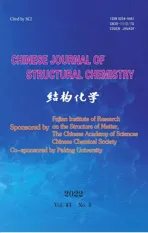Two Polynuclear Fe Complexes with Boat-like Core:Syntheses, Structures and Magnetic Properties①
2022-04-16YANGNaYANGHuaTIANHaiQuanLIDaChengDOUJianMin
YANG Na YANG Hua TIAN Hai-Quan LI Da-Cheng DOU Jian-Min
(Shandong Provincial Key Laboratory of Chemical Energy Storage and Novel Cell Technology,School of Chemistry and Chemical Engineering, Liaocheng University, Liaocheng 252059, China)
ABSTRACT Two novel polynuclear complexes {NaFe4(μ4-O)(L)4(μ2-Cl)[Fe(CN)5NO](H2O)(DMF)2} (1) and{NaFe4(μ4-O)(L)4(μ2-OEt)[Fe(CN)5NO](H2O)(DMF)2} (2) have been prepared using the tetradentate N-(2-hydroxyethyl)-3-methoxysalicylaldimine Schiff-base ligand (H2L) with the help of [Fe(CN)5NO]2- linkers, where the ligand was in situ synthesized through the condensation of o-vanillin and ethanolamine in the formation process of complexes.The resulting complexes possess “boat-like” structure constructed through three Fe ions and one Na ion with the fourth Fe ion acting as the “paddle”. The “hull bottom” contains an eight-membered metallamacrocycle with metallacrown-like motif and [-M-O-] repeat unit. Both complexes display three-dimensional frameworks through C-H···N hydrogen bonds, C-H···Cl hydrogen bonds, and π-π stacking interactions with the introduction of solvent molecules and coordination anions. Variable-temperature magnetic susceptibility measurements reveal strong antiferromagnetic couplings between the metal centers in complexes 1 and 2.
Keywords: crystal structures, magnetic properties, Schiff-base, metallamacrocycle;
1 INTRODUCTION
Coordination complexes have attracted considerable attention due to their charming structures and various properties in the areas of molecular magnetism, catalysis, luminescence, bioactivities and so on[1-5]. Moreover, metal complexes not only exhibit definitive structures and metal coordination environment, but also serve as remarkable candidates to study single molecule magnets (SMMs). The magnetic performance reveals that the magnetic properties depend on the paramagnetic metal ions, such as transition metal ions (MnIII, FeIII, CoII)[6-8]and lanthanide ions (DyIII, TbIII,ErIII)[9,10], the coupling interactions, as well as the effect of ligand field[11-14]. While solvent molecules, assistant ligands and/or other anions can influence the supramolecular structures and coordination enviroment, which would further change the ligand-field of metal centers. As a result, magnetic behavior would be influenced or changed[15]. Usually, in the design of complexes, the researcher will combine the paramagnetic metal ions with the large magnetic anisotropy or high spin-orbit coupling and multidendate ligand into an experiment process, and/or add the second assistant ligand to enrich the structures and properties. Therefore, it is promising to obtain the expected products through choosing suitable ligands and metal ions, as well as controlling the coordination environment through assistant ligand or solvent molecules, and further explore the supramolecular interactions and relevant properties.
Metallacrowns (MCs) are inorganic metal macrocyclic complexes, regarded as metal ions and nitrogen atoms replacing the methylene carbon atoms of crown ethers to exhibit -[M-N-O]- repeat unit in their ring[16,17]. Since Pecoraro and Lah reported the first metallacrown in 1989, a variety of metallacrowns have been synthesized with the structural types consisting of 9-MC-3, 12-MC-4, 15-MC-5,18-MC-6, 24-MC-8, 30-MC-10, 45-MC-12 and 60-MC-20.The reaserch fields involved coordination polymers[18-20],molecular magnetisms[21,22], luminescence[23,24]and magnetic resonance imaging contrasts[25]. Numerous homometallic FeIIIMCs have been reported with the structure Containing FeIII[9-MCFeIIIN(shi)-3][26], CuII[12-MCFeIIIN(Shi)-4][27],[18-MCFeIII-6][28,29], and their magnetocaloric effect has been discussed in detail. The recent studies of molecular magnets showed that the high spin FeIIIcomplexes withS= 5/2 spin state presented spin crossover (SCO)[30,31]. Herein, in our experiment process, we chose tetradentate Schiff-base ligands(N-(2-hydroxyethyl)-3-methoxysalicylaldimin H2L) with rich N, O donors, high-spin FeIIIions as well as the bridging sodium nitroprusside to synthesize Fe-based complexes.Successfully, two polynuclear complexes {NaFe4(μ4-O)(L)4(μ2-Cl)[Fe(CN)5NO](H2O)(DMF)2} and {NaFe4(μ4-O)(L)4(μ2-OEt)[Fe(CN)5NO](H2O)(DMF)2} were obtained,and their structures were characterized through X-ray singlecrystal diffraction, elemental analysis, IR and spectroscopic analysis, as well as their supramolecular frameworks and magnetic properties were explored in detail.
2 EXPERIMENTAL
2. 1 Materials and methods
All the chemical materials were commercially available and used as received. Elemental analyses for C, H, and N were acquired using an Elementar Vario EL analyzer. The infrared spectra were recorded from KBr disks in the range of 400~4000 cm-1on a Nicolet iS50 FT-IR spectrometer.Powder X-ray diffraction patterns were obtained on a Smart Lab. Variable temperature magnetic susceptibility measurements were carried out on a Quantum Design MPMS-XL7 SQUID magnetometer.
2. 2 Synthesis of complex 1
A solution ofo-vanillin (0.1522 g, 1 mmol) and ethanolamine (0.0611 g, 1 mmol) in 12 mLN,N-dimethylformamide(DMF) was stirred for 0.5 h at room temperature. With stirring, triethylamine (0.1012 g, 1 mmol) was added into the above solution, and then FeCl3·6H2O (0.2703 g, 1 mmol)was added to the above solution. After stirring for 2 h, the mixture became black. Then, a solid Na2[Fe(CN)5NO]·2H2O(0.2979 g, 1 mmol) was added and the mixture was stirred for another 2 h. The solution was filtered and the filtrate was layered with EtOH and Et2O. The black block crystals suitable for X-ray analysis were obtained within a week with about 48% yield on Fe. Anal. Calcd. (%) for C51H59ClFe5N12NaO17:C, 42.28; H, 4.04; N, 11.60. Found: C, 42.25; H, 4.08; N,11.57. IR (KBr, cm-1): 3431 (br), 2933 (br), 2142 (w), 1885(s), 1633 (vs), 1552 (w), 1471 (m), 1391 (w), 1305 (m),1222 (s), 1035 (w), 971 (w), 865 (w), 739 (m), 632 (w), 524(w).
2. 3 Synthesis of complex 2
A solution ofo-vanillin (0.1522 g, 1 mmol) and ethanolamine (0.0611 g, 1 mmol) in 9 mLDMF and 3 mL acetonitrile was stirred for 0.5 h at room temperature. With stirring, triethylamine (0.2024 g, 2 mmol) was added into the above solution. Then, into the light yellow solution,FeCl3·6H2O (0.2703 g, 1 mmol) was added. After stirring for 2 h, the mixture became black, and a solid,Na2[Fe(CN)5NO]·2H2O (0.2979 g, 1 mmol), was added followed by further stirring for another 2 h. The solution was filtered and the filtrate was layered with EtOH and Et2O. The black block crystals suitable for X-ray analysis were obtained within a week with about 45% yield based on Fe.Anal. Calcd. (%) for C53H65Fe5N12NaO18: C, 43.55; H, 4.45;N, 11.50. Found (%): C, 43.58; H, 4.43; N, 11.48. IR (KBr,cm-1): 3423 (br), 2922 (br), 2141 (w), 1885 (s), 1633 (vs),1552 (w), 1471 (m), 1391 (w), 1307 (m), 1221 (s), 1035 (w),972 (w), 865 (w), 739 (m), 619 (w), 426 (w).
2. 4 X-ray structure determination
X-ray diffraction data for 1 and 2 were obtained on an Agilent Xcalibur Eos Gemini CCD plate diffractometer equipped with graphite monochromatic CuKαradiation (λ=1.54184 Å). All the crystal structures were solved by direct methods using the SHELXS-18 program and refined by the full-matrix least-squares onF2using the SHELXL program[32]. Non-hydrogen atoms are refined with displacement temperature parameters. Hydrogen atoms of the organic ligand are theoretically determined with isotropic thermal displacement parameters. Table 1 shows the crystal data and structure refinement of 1 and 2. Selected bond lengths and bond angles for 1 and 2 are listed in Table S3 and Table S4.

Table 1. Crystal Data and Structure Refinement for 1 and 2
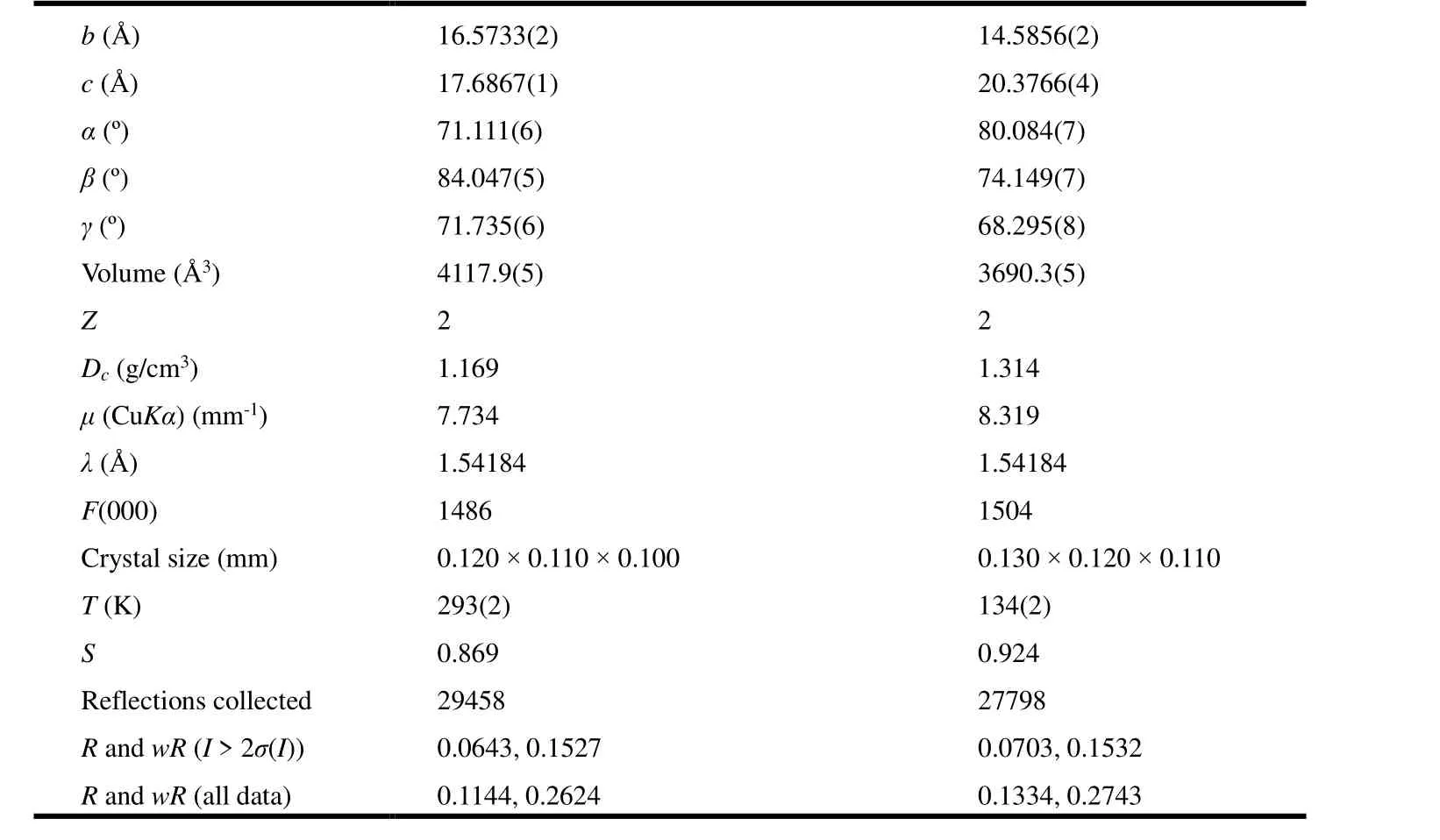
b (Å)c (Å)α (º)β (º)γ (º)Volume (Å3)Z Dc (g/cm3)μ (CuKα) (mm-1)λ (Å)F(000)Crystal size (mm)T (K)S Reflections collected R and wR (I > 2σ(I))R and wR (all data)16.5733(2)17.6867(1)71.111(6)84.047(5)71.735(6)4117.9(5)2 1.169 7.734 1.54184 1486 0.120 × 0.110 × 0.100 293(2)0.869 29458 0.0643, 0.1527 0.1144, 0.2624 14.5856(2)20.3766(4)80.084(7)74.149(7)68.295(8)3690.3(5)2 1.314 8.319 1.54184 1504 0.130 × 0.120 × 0.110 134(2)0.924 27798 0.0703, 0.1532 0.1334, 0.2743
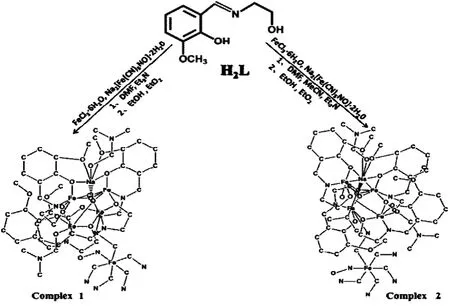
Scheme 1. Syntheses of 1 and 2
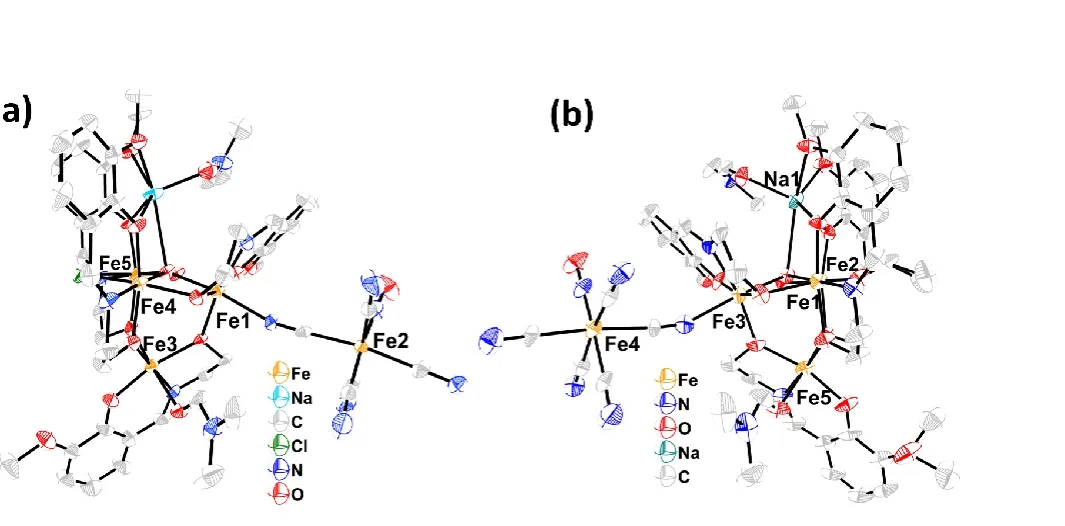
Fig. 1. Molecular structures of (a) 1 and (b) 2
3 RESULTS AND DISCUSSION
3. 1 Synthesis and characterization
The reaction of FeCl3·6H2O with N-(2-hydroxyethyl)-3-methoxysalicylaldimine (H2L) in a 1:1 molar ratio in DMF solution yielded complexes {NaFe4(μ4-O)(L)4(μ2-Cl)[Fe-(CN)5NO](H2O)(DMF)2} (1) and {NaFe4(μ4-O)(L)4(μ2-OEt)-[Fe(CN)5NO](H2O)(DMF)2} (2). It can be seen from Scheme 1 that 1 was isolated with a chloride bridging two Fe ions, while the addition of MeCN solvent resulted into the information of 2 with oneμ2-OEt replacingμ2-Cl-to bridge two Fe ions. The PXRD of the crystals revealed the purity of 1 and 2 in Fig. S1.
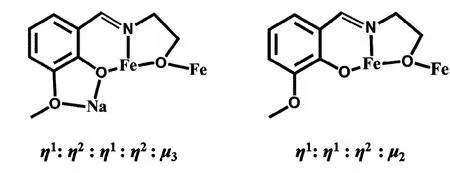
Scheme 2. Coordination modes of L
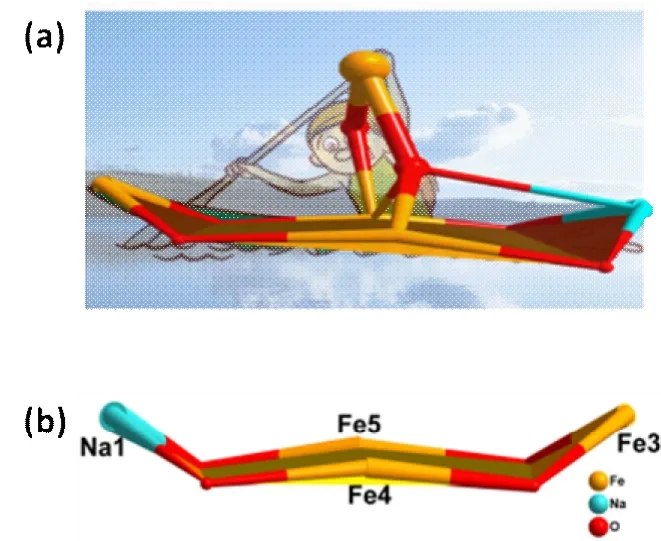
Fig. 2. (a) A boat-like core with a hypothetical person rowing, (b) Analogous [8-MC-4] metallacrown-like motif
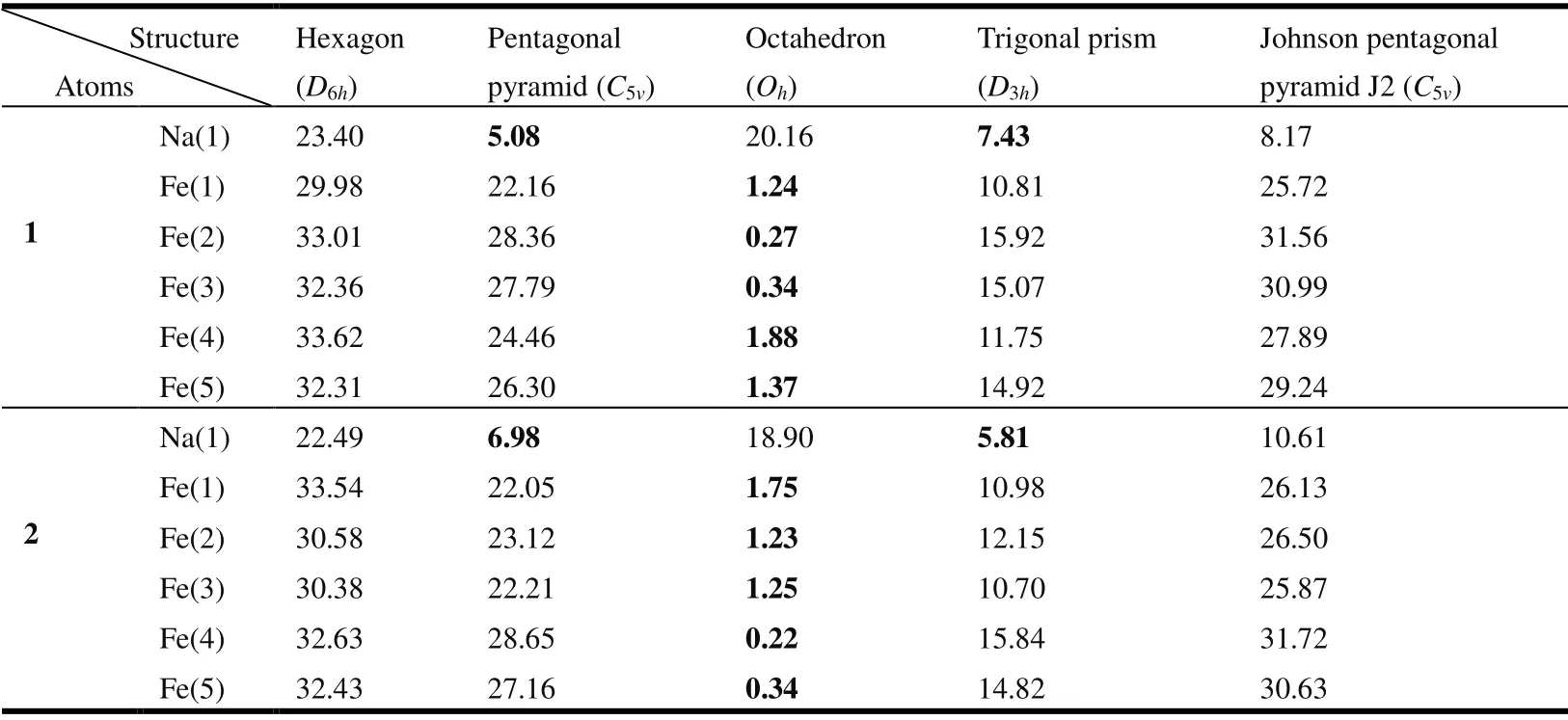
Table 2. Na and Fe Ion Coordination Configurations for 1 and 2

Table 3. Bond Valence Calculations (BVS) for 1 and 2
3. 2 Crystal structure of 1
Complex 1 crystallizes inP1 space group and triclinic crystal system (Table 1) with the molecular structure exhibiting a trigonal bipyramidal configuration, where three Fe ions are located in the triangle core and one Fe and one Na occupy the apical positions. The simple presentation of the molecular structure is shown in Fig. 1(a). Three Fe ions from the equatorial plane are held together through oneμ4-O atom with the other coordination atoms supplied by four ligands,and one H2O molecule, one bridgeμ2-Cl ion as well as one N atom from [Fe(CN)5NO]2-. Four ligands exhibit two coordination modes,η1:η2:η1:η2:μ3andη1:η1:η2:μ2(Scheme 2). Three Fe ions are located in a hexa-coordination environment. For Fe(4), the coordination atoms consist of three donors (O(2), N(4), O(3)) of one ligand, one bridgeμ2-Cl(1)and oneμ4-O(18), as well as one O(9) atom from the second ligand; the coordinate atoms of Fe(5) come from three donors (O(12), N(1), O(13)) of one ligand, one bridgeμ2-Cl(1) and oneμ4-O(18), as well as one O(7) atom from a water molecule; while for Fe(1), the coordination atoms are supplied by three donors (O(8), N(3), O(9)) of one ligand,oneμ4-O(18) and one N(9) atom from [Fe(CN)5NO]2-, oneμ2-O(6) which further bridges Fe(1) and Fe(3). Fe(3) and Na(1) occupying the apical positions are also hexacoordinated. For Fe(3), the coordination atoms come from three donors (O(5), N(2), O(6)) of one ligand and one O(15)atom from a DMF molecule, as well as twoμ2-O (O(3),O(13)) atoms of two ligands; for Na(1), the coordination atoms consist of oneμ4-O(18) and one O(14) atom of a DMF molecule, as well as four coordinated O (O(1), O(2), O(11),O(12)) atoms of two ligands. The metal skeleton of 1 is also described as a “boat-like” core constructed through three Fe ions and one Na ion with the fourth Fe ion acting as “paddle” or “ ship man” (Fig. 2(a)). The “hull bottom” contains a metallamacrocycle with metallacrown-like motif (Fig. 2(b)).The analogue of metallacrown can be recognized as an 8-MC-4 type with adjacent metal connected by O atom to exhibit [-M-O-] repeat unit. There are two different bridging groups among the metal centrals. The Fe-O-Fe angles are 125.3(2)° for Fe(3)-O(3)-Fe(4) and 123.7(2)° for Fe(3)-O(13)-Fe(5). The Fe-O-Na(1) angles are 103.56(9)° and 104.1(2)° for Fe(4)-O(2)-Na(1) and Fe(5)-O(12)-Na(1),respectively. The coordination configurations of Fe and Na were calculated by SHAPE[33]. All Fe ions are all distorted octahedral configurations. The coordinated geometry of Na ion is close toC5vconfiguration. The specific coordination configuration data of Fe and Na ions are listed in Table 2.The oxidation states of Fe are determined according to the molecule structure, charge balance and BVS calculations[34].The BVS calculation data are shown in Table 3.
With deep analysis of the interactions among molecules,we found a larger number of hydrogen bonds andπ-πstacking interactions. As shown in Fig. 3(a), there are two types of hydrogen bonds between molecules, (C(8)-H(8)···N(11), C(31)-H(31C)···N(11), C(19)-H(19A)···N(7),C(34)-H(34)···N(7), C(41)-H(41C)···N(10)) and C-H···Cl(C(4)-H(4)···Cl(1)), and two types ofπ-πstacking interactions (Cg5···Cg5 and Cg4···Cg8). The distances between two centers for Cg4···Cg8 (Fig. 3(b)) and Cg5···Cg5 (Fig. 3(c))are 3.9628(3) and 3.6691(3) Å, respectively. The angles between the two centers for Cg4···Cg8 and Cg5···Cg5 are 5°and 0°, respectively. These rich intermolecular interactions lead to the formation of a three-dimensional supramolecular structure (Fig. 3(d)). The specific parameters of hydrogen bonds andπ-πstacking interactions can be obtained from Table S1 and Table S2.

Fig. 3. (a) Intermolecular interactions of 1, π-π stacking interactions of (b) Cg4···Cg8 and(c) Cg5···Cg5, (d) 3D supramolecular structure of 1
3. 3 Crystal structure of 2
Complex 2 crystallizes inP1 space group of triclinic crystal system (Table 1), and the difference with the structure of complex 1 is that the deprotonatedμ2-OEt anion displacesμ2-Cl-anion to bridge Fe(1) and Fe(2). The molecular structure of 2 is shown in Fig. 1(b). The coordinated geometry of Na ion is close toD3hconfiguration.The specific coordination configuration data and BVS calculation data of Fe and Na ions are listed in Tables 2 and 3, respectively. In 2, the three-dimensional supramolecular structure (Fig. 4(b)) is further constructed through C(30)-H(30A)···N(23), C(1D)-H(1D2)···N(24) and C(1G)-H(1G2)···N(24) interactions (Fig. 4(a)). Detailed data for these hydrogen bonds are also given in Table S1.

Fig. 4. (a) Hydrogen bonds and (b) 3D supramolecular structure of 2
3. 4 Magnetic properties
For 1 and 2, variable temperature magnetic susceptibilities(χMT) have been measured in the range of 1.8~300 K at 1000 Oe dc. TheχMTvalues of 1 and 2 at 300 K are 5.41 and 7.00 cm3·K·mol-1, respectively, lower than the expected value of 17.51 cm3·K·mol-1for four independent non-interacting FeIII(S= 5/2,g= 2) (Fig. 5(a) and 5(c)). As [Fe(CN)5NO]2-is diamagnetic, the exchange interaction between FeIIand FeIIIthrough the cyanide bridging ligand is negligible[35]. With decreasing the temperature, magnetic susceptibility values gradually decrease and reach 0.09 and 0.05 cm3·K·mol-1for 1 and 2 at 1.8 K, respectively. This phenomenon reveals that the interaction between four FeIIIions is antiferromagnetic coupling. The experimental susceptibility data were fitted through PHI software[36]with the best-fitting parameters ofJ1= -11.3,J2= -16.4,J3= -19.2 cm-1for 1 andJ1= -21.8,J2= -11.5 cm-1for 2, respectively. The field depended magnetization (M) curves of 1 and 2 at different temperature are shown in Fig. 5(b) and 5(d), respectively.Mvalues increase linearly at low field without reaching the saturation at highfield region. The curves ofMvsH/Tat different temperature also does not overlap, suggesting the presence of magnetic anisotropy. In order to further study the magnetic properties of 1 and 2, we measured the ac magnetic susceptibility at 0 and 2000 Oe dc fields, respectively, with the frequency range of 1~999 Hz and temperature range from 2 to 12 K.The analysis of ac magnetic susceptibilities finds that the in-phase (χ'M) and out-of-phase (χ"M) of 1 and 2 do not show obvious frequency dependence at two fields. Here, only 2000 Oe field-inducedχ'Mandχ"Mplots are given in Fig. 6.A reason likely derives from the structural symmetry, which offsets the magnetic coupling interaction and makes the title complexes exhibit unsatisfactory magnetic behavior[37].

Fig. 5. Plots of χMT vs. T (a) and M/NμB vs. H/T (b) for 1;Plots of χMT vs. T (c) and M/NμB vs. H/T (d) for 2
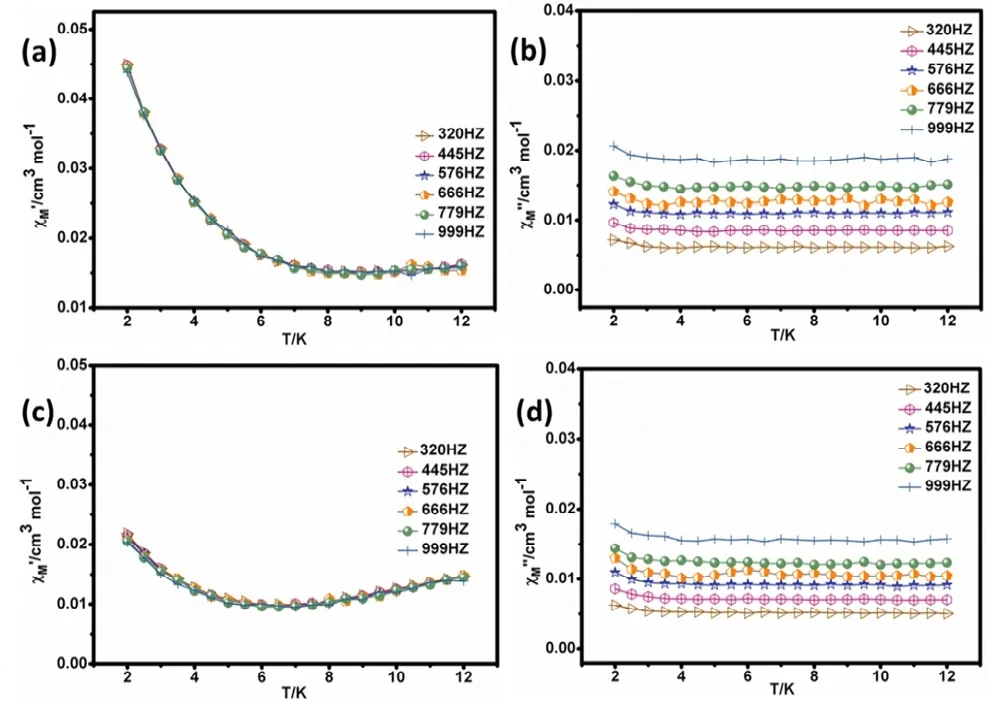
Fig. 6. The ac susceptibility temperature dependent diagram at 2000 Oe field:plots of χ'M vs. T (a) and χ"M vs. T(b) of 1; plots of χ'M vs. T (c) and χ"M vs. T (d) of 2
4 CONCLUSION
We obtained two novel polynuclear Fe complexes, where four Fe ions and one Na ion exhibited a trigonal bipyramidal arrangement with three Fe ions locating in the triangle core,and one Fe and one Na ions occupying the apical positions.The metal skeleton is also described as a “boat-like” core constructed through three Fe and one Na ions with the fourth Fe ion acting as the “paddle” or “ship man”. The “hull bottom” contains a metallamacrocycle with metallacrown-like motif. The analogue of metallacrown can be recognized as an 8-MC-4 type with adjacent metal connected by O atom to exhibit [-M-O-] repeat unit. In 1, a three-dimensional structure is constructed by hydrogen bonds andπ-πstacking interactions. 2 also represents a three-dimensional structure, in which the involved supramolecular interactions consist of hydrogen bonds. Magnetic studies have revealed the presence of antiferromagnetic coupling between metal centers,and the structural symmetry likely offset the magnetic coupling interaction.
杂志排行
结构化学的其它文章
- Structural and Electronic Properties of Lutetium Doped Germanium Clusters LuGen(+/0/-) (n = 6~19):A Density Functional Theory Investigation①
- Discovery of Benzimidazole Derivatives as Novel Aldosterone Synthase Inhibitors: QSAR, Docking Studies, and Molecular Dynamics Simulation①
- QSAR Models for Predicting Additive and Synergistic Toxicities of Binary Pesticide Mixtures on Scenedesmus Obliquus①
- Preparation, Crystal Structure and Fungicidal Activity of N-(5-(benzofuranol-7-oxymethyl)-1,3,4-thiadiazol-2-yl)amide Compounds①
- Antibiotic Silver Particles Coated Graphene Oxide/polyurethane Nanocomposites Foams and Its Mechanical Properties①
- Planar Tetracoordinate Carbon in 6σ + 2π Double Aromatic CBe42- Derivatives①
